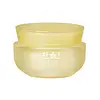What's inside
What's inside
 Key Ingredients
Key Ingredients

 Benefits
Benefits

 Concerns
Concerns

 Ingredients Side-by-side
Ingredients Side-by-side

Water
Skin ConditioningGlycerin
HumectantCyclopentasiloxane
EmollientBetaine
HumectantDimethicone
EmollientC12-15 Alkyl Benzoate
AntimicrobialPolyacrylamide
Phenoxyethanol
PreservativeCetearyl Olivate
C13-14 Isoparaffin
EmollientSorbitan Olivate
EmulsifyingDimethiconol
EmollientPhenyl Trimethicone
Skin ConditioningLaureth-7
EmulsifyingCarbomer
Emulsion StabilisingDisodium EDTA
Tocopheryl Acetate
AntioxidantUrea
BufferingParfum
Masking3-O-Ethyl Ascorbic Acid
Skin ConditioningButylene Glycol
HumectantCaprylyl Glycol
EmollientPotassium Hydroxide
BufferingSodium Citrate
BufferingBenzophenone-4
UV AbsorberLimonene
PerfumingDipropylene Glycol
HumectantAscorbyl Tetraisopalmitate
AntioxidantDimethicone Crosspolymer
Emulsion StabilisingBenzyl Benzoate
AntimicrobialHexyl Cinnamal
PerfumingLinalool
PerfumingButylphenyl Methylpropional
PerfumingBenzyl Salicylate
PerfumingCitrus Junos Fruit Extract
Skin ConditioningCitral
PerfumingHydroxycitronellal
PerfumingDenatonium Benzoate
MaskingWater, Glycerin, Cyclopentasiloxane, Betaine, Dimethicone, C12-15 Alkyl Benzoate, Polyacrylamide, Phenoxyethanol, Cetearyl Olivate, C13-14 Isoparaffin, Sorbitan Olivate, Dimethiconol, Phenyl Trimethicone, Laureth-7, Carbomer, Disodium EDTA, Tocopheryl Acetate, Urea, Parfum, 3-O-Ethyl Ascorbic Acid, Butylene Glycol, Caprylyl Glycol, Potassium Hydroxide, Sodium Citrate, Benzophenone-4, Limonene, Dipropylene Glycol, Ascorbyl Tetraisopalmitate, Dimethicone Crosspolymer, Benzyl Benzoate, Hexyl Cinnamal, Linalool, Butylphenyl Methylpropional, Benzyl Salicylate, Citrus Junos Fruit Extract, Citral, Hydroxycitronellal, Denatonium Benzoate
Water
Skin ConditioningGlycerin
HumectantButylene Glycol
HumectantMethyl Trimethicone
Skin ConditioningHydrogenated Poly(C6-14 Olefin)
EmollientTrehalose
HumectantNiacinamide
SmoothingAlcohol
AntimicrobialPCA Dimethicone
Skin Conditioning1,2-Hexanediol
Skin ConditioningBehenyl Alcohol
EmollientJojoba Esters
EmollientAcrylates/C10-30 Alkyl Acrylate Crosspolymer
Emulsion StabilisingCnidium Officinale Root Water
MaskingAngelica Acutiloba Root Water
Skin ConditioningHydroxyethyl Acrylate/Sodium Acryloyldimethyl Taurate Copolymer
Emulsion StabilisingHelianthus Annuus Seed Oil
EmollientLimonene
PerfumingAmmonium Acryloyldimethyltaurate/Beheneth-25 Methacrylate Crosspolymer
Emulsion StabilisingTromethamine
BufferingCitrus Junos Peel Oil
AstringentXanthan Gum
EmulsifyingGlyceryl Caprylate
EmollientDaucus Carota Sativa Root Extract
Skin ConditioningDisodium EDTA
Ethylhexylglycerin
Skin ConditioningGeraniol
PerfumingAdenosine
Skin ConditioningSorbitan Isostearate
EmulsifyingLinalool
Perfuming3-O-Ethyl Ascorbic Acid
Skin ConditioningBeta-Carotene
Skin ConditioningFarnesol
PerfumingTocopherol
AntioxidantCymbopogon Martini Oil
MaskingCitrus Junos Peel Extract
Skin ConditioningWater, Glycerin, Butylene Glycol, Methyl Trimethicone, Hydrogenated Poly(C6-14 Olefin), Trehalose, Niacinamide, Alcohol, PCA Dimethicone, 1,2-Hexanediol, Behenyl Alcohol, Jojoba Esters, Acrylates/C10-30 Alkyl Acrylate Crosspolymer, Cnidium Officinale Root Water, Angelica Acutiloba Root Water, Hydroxyethyl Acrylate/Sodium Acryloyldimethyl Taurate Copolymer, Helianthus Annuus Seed Oil, Limonene, Ammonium Acryloyldimethyltaurate/Beheneth-25 Methacrylate Crosspolymer, Tromethamine, Citrus Junos Peel Oil, Xanthan Gum, Glyceryl Caprylate, Daucus Carota Sativa Root Extract, Disodium EDTA, Ethylhexylglycerin, Geraniol, Adenosine, Sorbitan Isostearate, Linalool, 3-O-Ethyl Ascorbic Acid, Beta-Carotene, Farnesol, Tocopherol, Cymbopogon Martini Oil, Citrus Junos Peel Extract
 Reviews
Reviews

Ingredients Explained
These ingredients are found in both products.
Ingredients higher up in an ingredient list are typically present in a larger amount.
You might know this ingredient as Ethyl Ascorbic Acid, a more stable version of ascorbic acid.
Like other types of vitamin C, this ingredient has many benefits including reducing wrinkles, skin soothing, dark spot fading, and fighting against free radicals.
3-O-Ethyl Ascorbic Acid interferes with the process of skin darkening, helping to reduce hyperpigmentation. It also encourages the skin to produce more collagen.
Once applied, 3-O-Ethyl Ascorbic Acid is converted to Vitamin C deeper in the skin's layers. This process is slow but makes this ingredient more tolerable for skin.
The optimum pH range for this ingredient is 4 - 5.5
Learn more about 3-O-Ethyl Ascorbic AcidButylene Glycol (or BG) is used within cosmetic products for a few different reasons:
Overall, Butylene Glycol is a safe and well-rounded ingredient that works well with other ingredients.
Though this ingredient works well with most skin types, some people with sensitive skin may experience a reaction such as allergic rashes, closed comedones, or itchiness.
Learn more about Butylene GlycolDisodium EDTA plays a role in making products more stable by aiding other preservatives.
It is a chelating agent, meaning it neutralizes metal ions that may be found in a product.
Disodium EDTA is a salt of edetic acid and is found to be safe in cosmetic ingredients.
Learn more about Disodium EDTAGlycerin is already naturally found in your skin. It helps moisturize and protect your skin.
A study from 2016 found glycerin to be more effective as a humectant than AHAs and hyaluronic acid.
As a humectant, it helps the skin stay hydrated by pulling moisture to your skin. The low molecular weight of glycerin allows it to pull moisture into the deeper layers of your skin.
Hydrated skin improves your skin barrier; Your skin barrier helps protect against irritants and bacteria.
Glycerin has also been found to have antimicrobial and antiviral properties. Due to these properties, glycerin is often used in wound and burn treatments.
In cosmetics, glycerin is usually derived from plants such as soybean or palm. However, it can also be sourced from animals, such as tallow or animal fat.
This ingredient is organic, colorless, odorless, and non-toxic.
Glycerin is the name for this ingredient in American English. British English uses Glycerol/Glycerine.
Learn more about GlycerinLimonene is a fragrance that adds scent and taste to a formulation.
It's found in the peel oil of citrus fruits and other plants such as lavender and eucalyptus. The scent of limonene is generally described as "sweet citrus".
Limonene acts as an antioxidant, meaning it helps neutralize free radicals.
When exposed to air, oxidized limonene may sensitize the skin. Because of this, limonene is often avoided by people with sensitive skin.
The term 'fragrance' is not regulated in many countries. In many cases, it is up to the brand to define this term. For instance, many brands choose to label themselves as "fragrance-free" because they are not using synthetic fragrances. However, their products may still contain ingredients such as essential oils that are considered a fragrance.
Learn more about LimoneneLinalool is a fragrance and helps add scent to products. It's derived from common plants such as cinnamon, mint, citrus, and lavender.
Like Limonene, this ingredient oxidizes when exposed to air. Oxidized linalool can cause allergies and skin sensitivity.
This ingredient has a scent that is floral, spicy tropical, and citrus-like.
Learn more about LinaloolWater. It's the most common cosmetic ingredient of all. You'll usually see it at the top of ingredient lists, meaning that it makes up the largest part of the product.
So why is it so popular? Water most often acts as a solvent - this means that it helps dissolve other ingredients into the formulation.
You'll also recognize water as that liquid we all need to stay alive. If you see this, drink a glass of water. Stay hydrated!
Learn more about Water